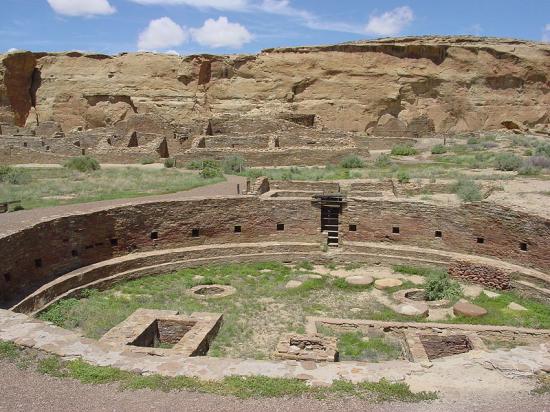Source - http://popular-archaeology.com/issue/06052014/article/did-deforestation-really-lead-to-societal-collapse-in-chaco-canyon
University of New Mexico scientists suggest evidence is lacking.

An image of the ruins of Chetro Ketl in Chaco Canyon (New Mexico, United States); shown is the complex's great kiva
It has been a long-accepted notion that the great-house society of the AD 900 to 1150 puebloan Chaco Canyon culture of the American Southwest collapsed because of deforestation to build their impressive communities. It is popularly cited as an example and warning of how human society employs unsustainable land-use practices.
But not so fast, say these researchers.
According to studies conducted by W.H. Wills, Brandon L. Drake and Wetherbee B. Dorshow of the Department of Anthropology, University of New Mexico, there is no substantial evidence, archaeological or otherwise, to support the contention that the puebloan peoples who built the architecturally impressive 11th-12th century AD structures of Chaco Canyon in present-day New Mexico abandoned their homes and centers in the 13th century because they exhausted their resources—the self-imposed poor-land-use destruction model often cited as a warning by environmentalists and others for our own future.
"There is no direct evidence for human impacts on local woodlands during the Bonito Phase [the period of high construction from AD 850 to 1150], no indication that agricultural fields were destroyed by deforestation or any other process, and, surprisingly, no conclusive information about the amount and sources of archaeological wood," write the researchers in their Perspective report, published in the Proceedings of the National Academy of Sciences. "Indeed, Chaco residents had available sources of timber and other natural resources that certainly were less costly than those indicated in collapse models."*
Between about AD 900 and 1150, Chaco Canyon was a major center of culture for the Ancient Pueblo Peoples. Chacoans quarried sandstone blocks and hauled timber from great distances, assembling fifteen major complexes that are thought to have been the largest buildings in North America north of Mexico until the 19th century. Some scientists suggest the Chacoans had a sophisticated knowledge of astronomical movements, as many of their buildings appear to have been aligned to capture the solar and lunar cycles, requiring generations of astronomical observations and centuries of skillfully coordinated construction. But all of this quickly came to an end in the 13th century, when the centers were mysteriously abandoned and were never revived. Many scholars have attributed the collapse to drought and/or deforestation.
For this study, the researchers based their conclusions on a review of past research, in addition to their own data collections and analysis of archaeological wood and cost-weighted distance to potential tree resources in the nearby regional mountain areas, as well as historical availability of local resources and other factors such as climate change or consistency.
"Our point," Wills, et al. continue, "is that we do not know where most of the wood in Chaco great houses originated, and we cannot eliminate local (canyon drainage) sources. Consequently there is no basis for concluding that the abandonment of Chaco Canyon was brought on by deforestation, improvident use of natural resources, or unstable exchange relationships, and therefore there is no reason to use Chaco’s history as a warning from the past about societal failure."*
And changing climate (such as the 50-year drought that commenced in 1130 AD) may not be the culprit either, they maintain.
"Construction patterns indicate that overall energy investment in Chaco great houses began to decline dramatically in the late AD 1000s, before the onset of any documented drought periods, and immigrants appear to have arrived in Chaco during the 12th century drought."*
Researchers and the public alike may never know. But for the present, at least for these researchers, the story remains very much an open-ended one.
* Wills, W.H., Brandon, L. Drake, Dorshow, Wetherbee B., Prehistoric deforestation at Chaco Canyon?,Perspective article, Proceedings of the National Academy of Sciences : www.pnas.org/cgi/doi/10.1073/pnas.1409646111